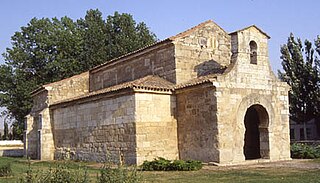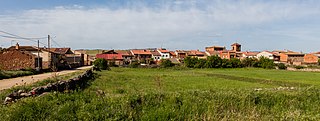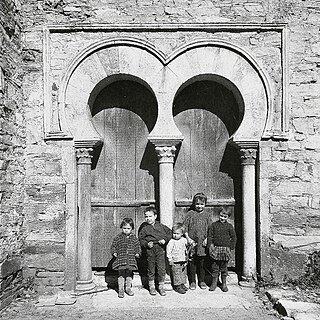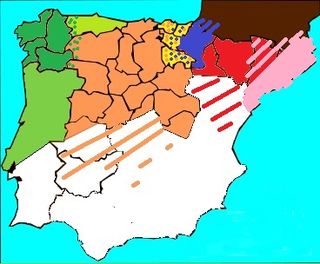
Soria is a municipality and a Spanish city, located on the Douro river in the east of the autonomous community of Castile and León and capital of the province of Soria. Its population is 38,881, 43.7% of the provincial population. The municipality has a surface area of 271,77 km2, with a density of 144.97 inhabitants/km2. Situated at about 1065 metres above sea level, Soria is the second highest provincial capital in Spain.

Lucena is a municipality of Spain belonging to the province of Córdoba, in the autonomous community of Andalusia.

The Visigoths entered Hispania in 415 and they rose to be the dominant people there until the Umayyad conquest of Hispania of 711 brought their kingdom to an end.
San Pedro, Spain may refer to the following places:

Spanish Baroque is a strand of Baroque architecture that evolved in Spain, its provinces, and former colonies.

Spanish Gothic architecture is the style of architecture prevalent in Spain in the Late Medieval period.

Duruelo de la Sierra is a municipality of Spain, in the province of Soria, Autonomous Community of Castile and León.

Nava de Roa is a municipality and town located in the municipality of Ribera del Duero, province of Burgos, Castile and León, Spain. It is located 92 km from Burgos, 26 km from Aranda de Duero, and 70 km from Valladolis. According to the 2004 census (INE), the municipality has a population of 246 inhabitants.

Ágreda is a municipality located in the province of Soria, in the autonomous community of Castile and León, Spain.

Almazán is a municipality located in the province of Soria, Castile and León, Spain. As of 2013, the municipality has a population of 5,843 inhabitants. It is also the seat of the judicial district of Almazán, and ecclesiastically it belongs to the Diocese of Osma, a suffragan diocese of the Archdiocese of Burgos. Connected via the Autovía A-15 and Carretera nacional N-111, it is situated 194 kilometres (121 mi) by road northeast of Madrid. The town lies on the east bank of the Duero river.

Montejo de Tiermes is a municipality located in the province of Soria, Castile and León, Spain. In 2010 the population of Montejo de Tiermes (municipality) was 198 inhabitants, 126 men and 72 women. Montejo de Tiermes (locality) had a population of 58 inhabitants on 1 January 2010, 41 men and 17 women.

San Pedro Manrique is a municipality in the province of Soria, Castile and León, Spain. As of 2009, it had 626 inhabitants. Since the mid-nineteenth century this municipality has aggregated smaller villages.

Mozarabic art is an early medieval artistic style that is part of the pre-Romanesque style and is linked to the kingdom of León. It was developed by the Hispanic Christians who lived in Muslim territory and in the expansion territories of the León crown, in the period from the Muslim invasion (711) to the end of the 11th century. During this period, disciplines such as painting, goldsmithing and architecture with marked Caliphate influences were cultivated in a context of medieval coexistence - Christian, Hebrew and Muslim - in which the territories were constantly changing in size and status. Other names for this artistic style are Leonese art or repopulation art.

The Diocese of Osma-Soria is a Latin Church ecclesiastical territory or diocese of the Catholic Church in northern Spain. It is a suffragan diocese in the ecclesiastical province of the metropolitan Archdiocese of Burgos. Its cathedral episcopal see is Catedral de Santa María de la Asunción, dedicated to the Assumption of Mary, in El Burgo de Osma. It also has a co-cathedral, Concatedral de San Pedro, dedicated to St. Peter, in Soria, and a minor basilica: Basílica de Nuestra Señora de los Miagros Miagros, in Ágreda, Soria, Castile and León, Spain.

The Cathedral of Burgo de Osma is a Roman Catholic church located in El Burgo de Osma, central Spain. It is in the Gothic architectural style, and was constructed on an area previously occupied by a Romanesque church. It is one of the best preserved medieval buildings in the country, and considered one of the best examples of thirteenth-century gothic architecture in Spain. The building of the church started in 1232, and was completed in 1784. The cloister is from 1512. The tower is from 1739. The cathedral is dedicated to the Assumption of Mary.

The Cathedral of St Peter the Apostle is a Catholic church located in Jaca, in Aragon, Spain. It is the seat of the Diocese of Jaca.

Spanish Romanesque designates the Romanesque art developed in the Hispanic-Christian kingdoms of the Iberian Peninsula in the 11th and 12th centuries. Its stylistic features are essentially common to the European Romanesque although it developed particular characteristics in the different regions of the peninsula. There is no Romanesque art in the southern half of the peninsula because it remained under Muslim rule (Al-Andalus). The examples of Romanesque buildings in the central area of the peninsula are sparse and of the latest period, with virtually no presence south of the Ebro and the Tagus. Most Romanesque buildings can be found in the northern third of the peninsula. Romanesque art was introduced into the peninsula from east to west, so scholars have usually defined regional characteristics accordingly: the "eastern kingdoms" comprising the Pyrenean areas, Catalan Romanesque, Aragonese Romanesque and Navarrese Romanesque, and the "western kingdoms" comprising Castilian-Leonese Romanesque, Asturian Romanesque, Galician Romanesque and Portuguese Romanesque.



















